Thousands of laser-cut pieces of Formica laminate make up Matt Lynch's and Curtis Goldstein's contemporary worker mosaics, like this one depicting Rumpke Recycling. Photo/Colleen Kelley/UC Creative Services
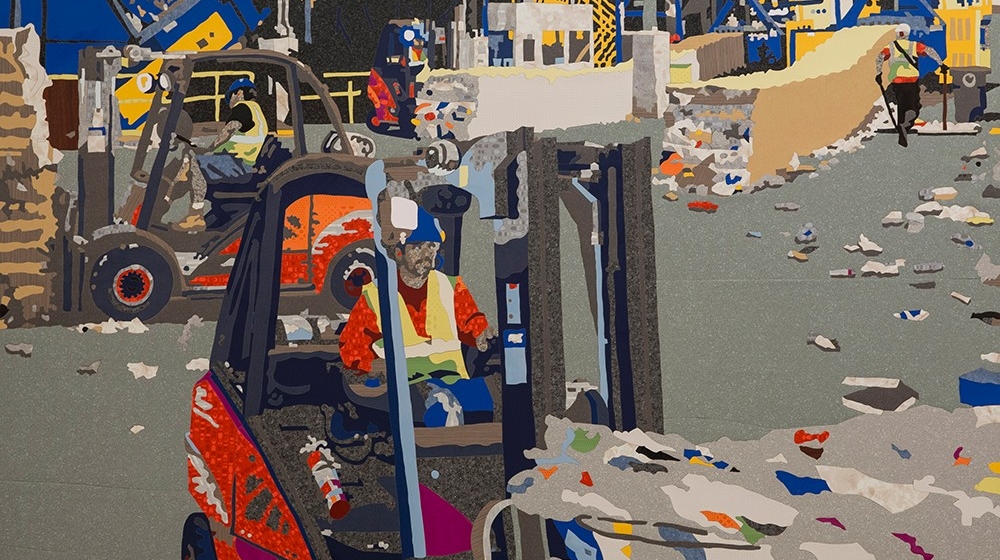
Reiss reimagined
UC artists revisit Union Terminal worker murals with modern mission and materials
by Jac Kern
513-556-1825
photos by Colleen Kelley,
UC Creative Services
Aug. 11, 2016
Consider it a new chapter in the ongoing story of Cincinnati industry.
As Winold Reiss’ iconic worker murals make the move from the Cincinnati airport to their new downtown home, two University of Cincinnati artists are reinterpreting the project from a unique, contemporary perspective.
Matt Lynch, associate professor in UC’s College of Design, Architecture, Art, and Planning, and alum Curtis Goldstein, MFA (DAAP) ’13, are creating a series of large-scale mosaics that depict today’s workers more objectively than the originals from 1933.
“Reiss staged his mural designs, creating a propagandistic ‘heroes of industry’ look typical of the era,” explains Goldstein. The new mosaics avoid nostalgic conventions in favor of authentic depictions of today’s labor and manufacturing, he says.
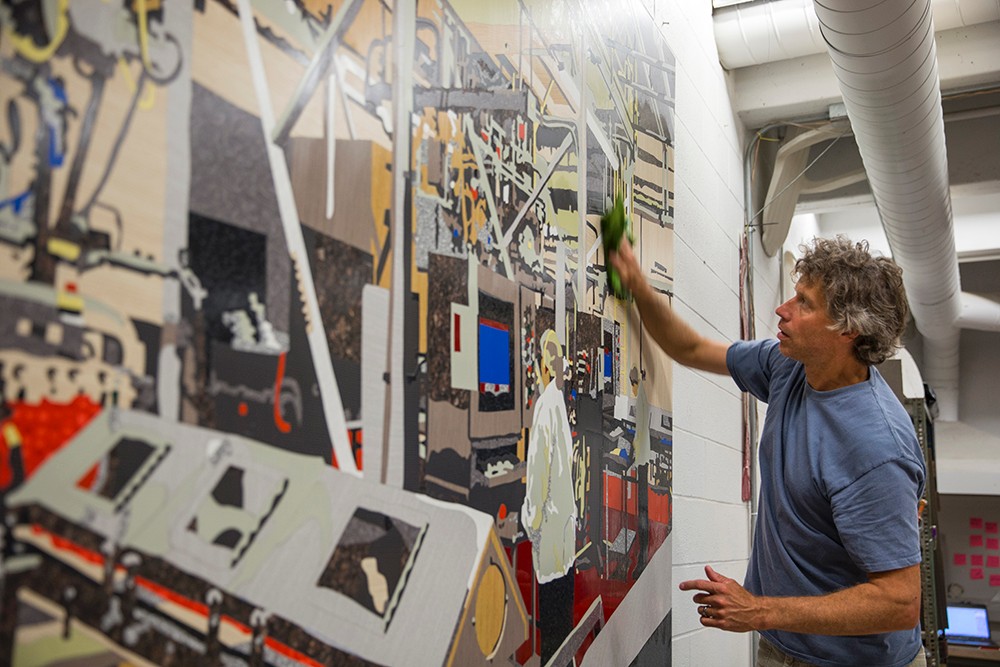
Matt Lynch cleans excess glue off a completed mosaic of the Airheads candy factory. Photo/Colleen Kelley/UC Creative Services
Where Reiss’ murals revealed a mostly white, male workplace with some subjects oiled up and positioned in Herculean poses, Goldstein’s and Lynch’s show a diverse mix of men and women in their natural work environments.
"We’re hoping — without organizing our subject too much — to run across more diversity, and we have,” Lynch explains.
“We haven’t even had to try,” Goldstein adds. “We’re not making sure of anything; that’s just how it comes out because that’s the reality. Which is a good thing.”
Instead of the 1930s industries Weiss depicted like the Kahn’s meat-packing plant, the modern versions portray factories such as Erlanger’s Perfetti Van Melle, where candy like Airheads is produced. The artists swapped Reiss’ glass mosaic tile for laser-cut laminate made by a DAAP studio sponsor, Formica. And while the originals graced the walls of Union Terminal, then the Cincinnati/Northern Kentucky International Airport and now the exterior of the Duke Energy Convention Center, the new pieces will appear in local galleries, on DAAP’s walls and, in some cases, in the factories themselves.
And just as the thousands of laminate cutouts come together to tell a story in their mosaics, many elements fell into place by chance to make this project possible.
Where Reiss’ murals starred mostly white men, sometimes oiled up and positioned in Herculean poses, Goldstein’s and Lynch’s show a diverse mix of men and women in their natural work environments. Instead of the 1930s industries Weiss depicted like the Kahn’s meat-packing plant, the new modern versions portray ones such as Erlanger’s Perfetti Van Melle factory, where candy like Airheads is produced. The artists swapped Reiss’ glass mosaic tile for laser-cut laminate made by a DAAP studio sponsor, Formica. And while the originals graced the walls of Union Terminal, then the Cincinnati/Northern Kentucky International Airport and now the exterior of the Duke Energy Convention Center, the new murals will appear in local galleries, on DAAP’s walls and, in some cases, in the factories themselves.
And just as the thousands of laminate cutouts come together to tell a story in their murals, many elements fell into place by chance to make this project possible.
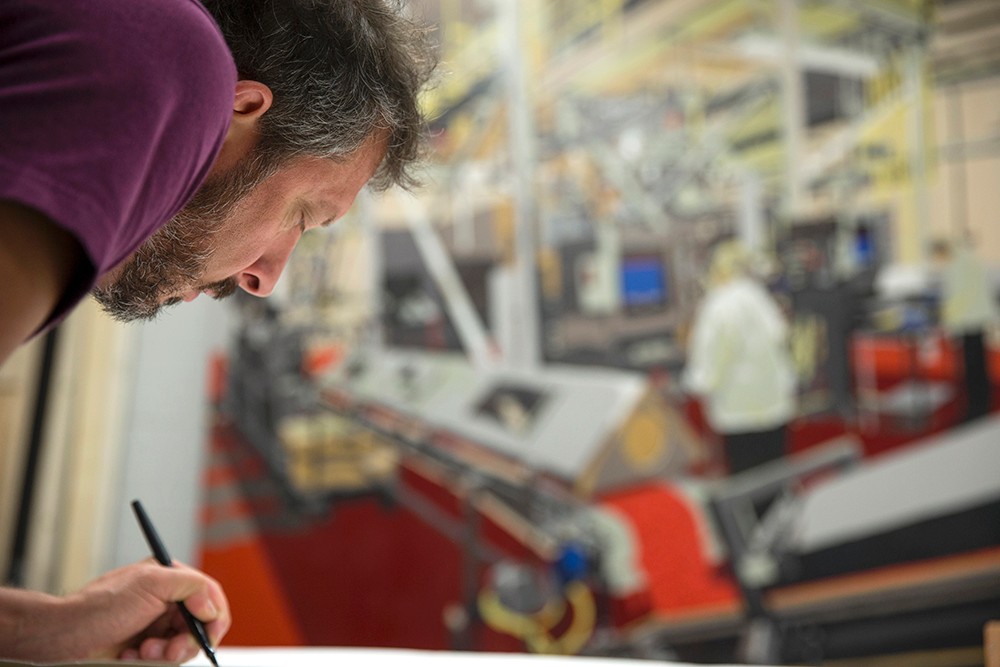
With a complete mosaic in the background, Curtis Goldstein works on a line drawing for the next subject — G.E. Aviation. Photo/Colleen Kelley/UC Creative Services
Formica came to be the main material in this project after the company sponsored a DAAP studio in spring 2015, in the hopes of encouraging a new generation of artists and designers to reconsider their familiar laminate. Formica provided materials and prize money for a contest that encouraged students to find a unique application for the material.
It was then that Lynch first began to experiment with Formica inlay techniques with the laser cutter, which could cut the brittle material without causing it to crack.
It was also a stroke of serendipity that brought the two artists together. They met when Goldstein, already an accomplished artist, went back to school to get his master’s at DAAP. As a painter who has created many public murals in the Midwest and beyond, he chose to go in a new direction and explore sculpture. “Because of all the tools, the excitement and the energy,” Goldstein explains. “And I wanted to experiment with new materials.”
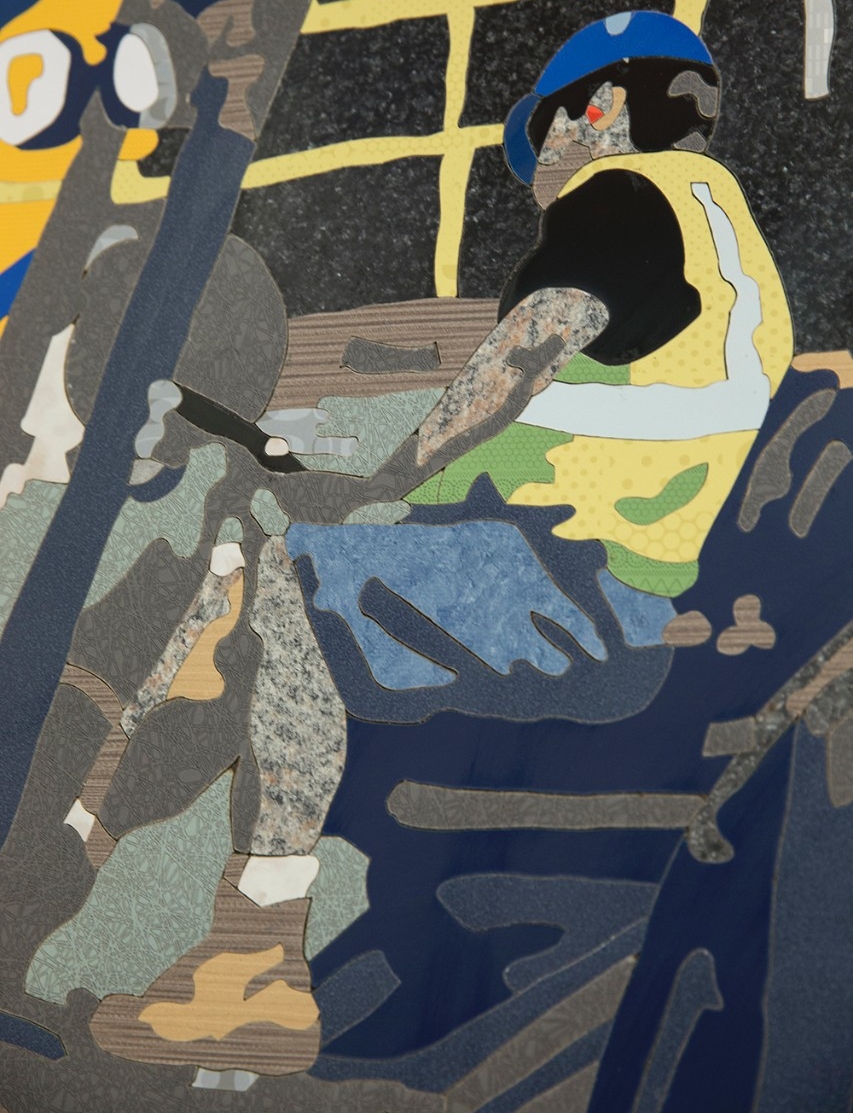
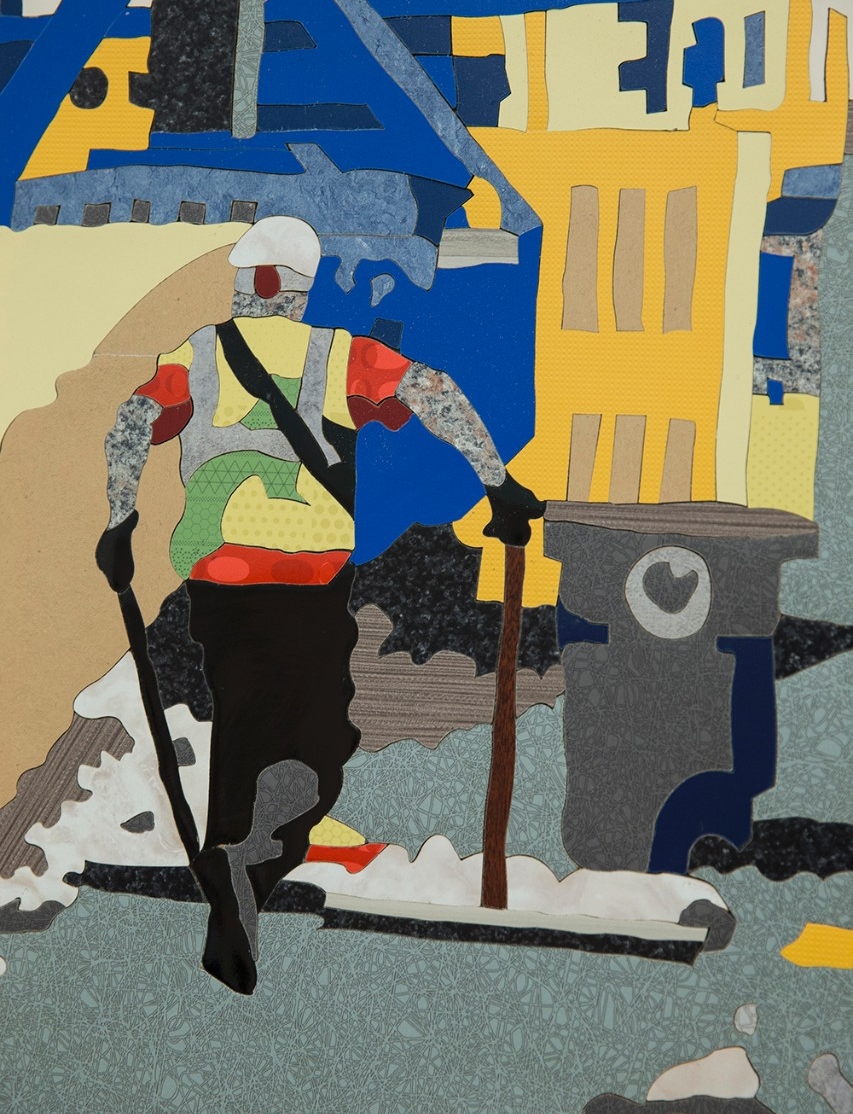
Close-up details of the Rumpke Recycling mosaic reveal the many tiny pieces of Formica laminate that make one cohesive image. Photo/Colleen Kelley/UC Creative Services
When he took an installation course with Lynch, they discovered that repurposing materials was just one interest they shared. They were both also experienced working on a large scale, fascinated with manufacturing and enjoyed touring factories. And with Lynch being a lifelong artistic collaborator, it was only a matter of time before the two teamed up.
The timing of their project is perfect, as local interest in the original Reiss’ works has been reignited with the nine murals being moved from a shuttered airport terminal to the downtown convention center. Lynch approached Goldstein with the idea of taking on these quintessential images, using the readily available Formica laminate as their chief material.
“I knew his appreciation of the historic nature of the project and that labor as the subject matter fits in with what I’ve know to be his interests,” Lynch says of Goldstein.
“And we also share this interest in how things are made, materials and the politics behind manufacturing and labor, which is very timely,” Goldstein adds. “A lot was in response to the way labor and trade and manufacturing have shifted internationally.”
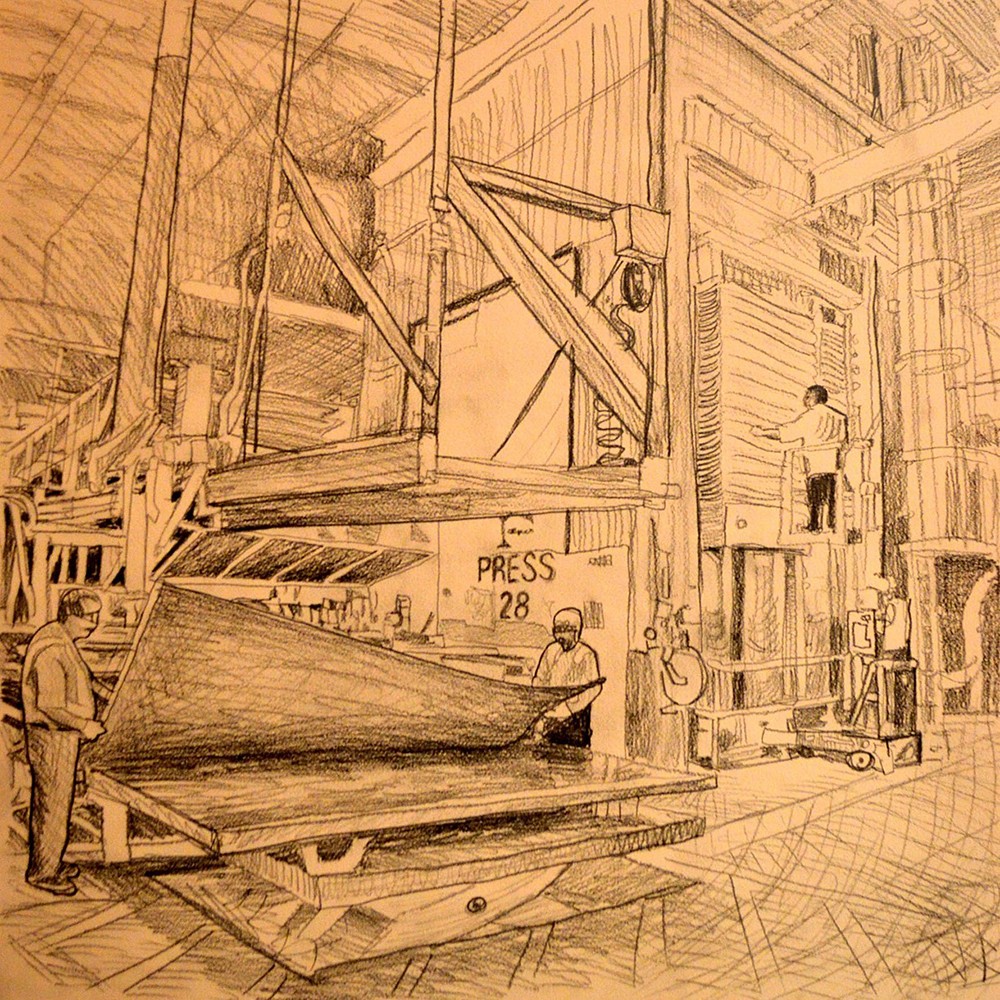

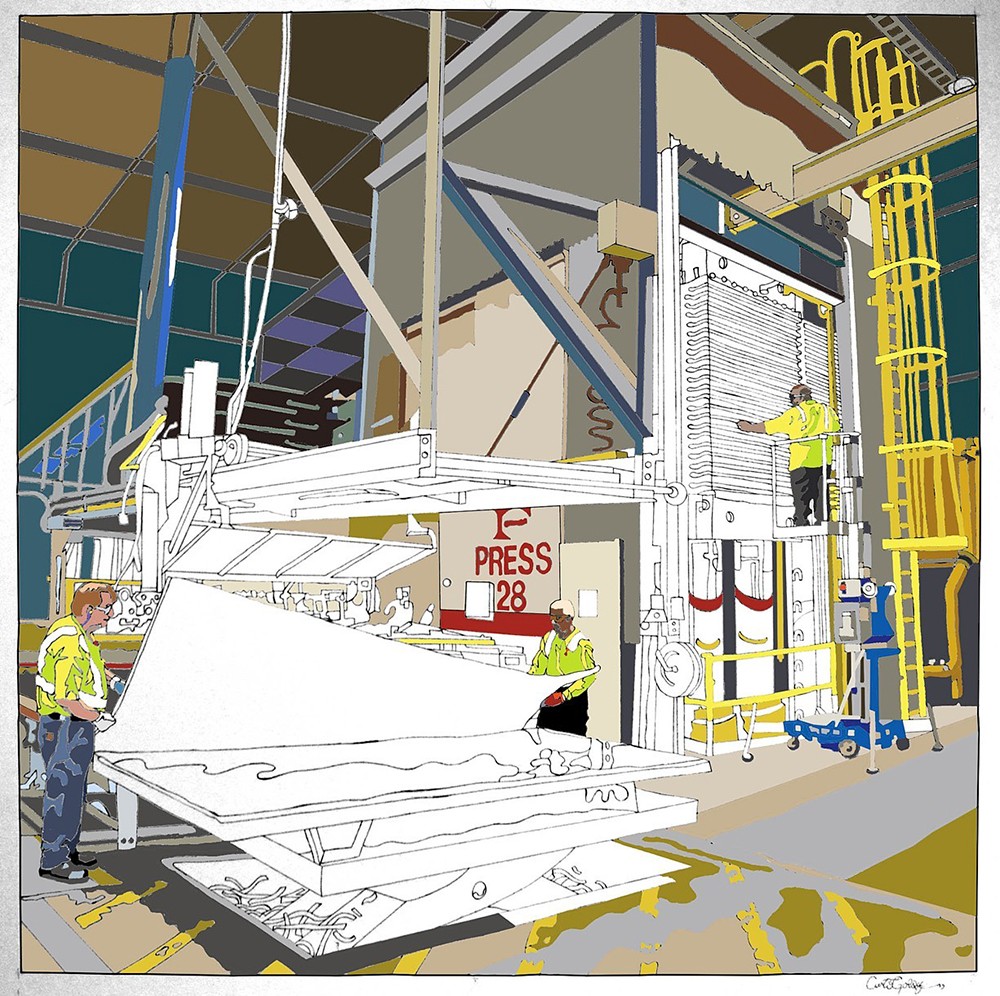
After touring and taking photos of the Formica Corporation, Goldstein starts with a rough sketch (left), refines it into a line drawing (center) and then makes color selections digitally (right). Photos/provided
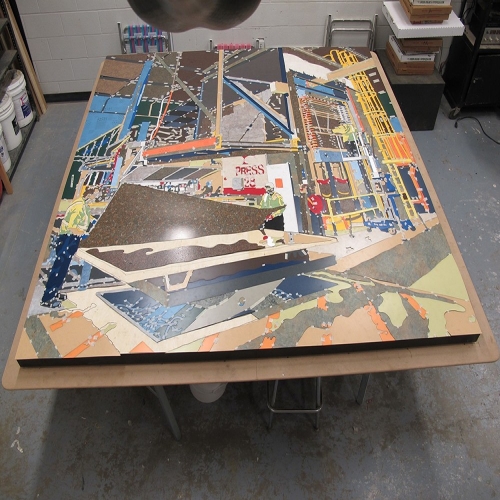
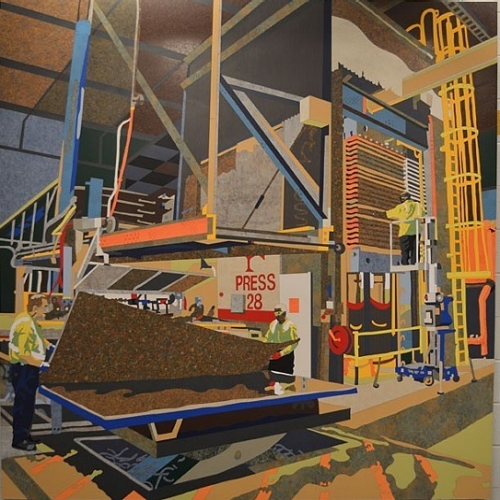
Finally, the laminate is cut, assembled and taped down (left) before being glued into place in the finished product — a mosaic depicting the Formica factory, made of Formica laminate (right). Photos/provided
While the new mosaics take on a meaning all their own, Reiss’ influence is apparent to anyone familiar with his Union Terminal pieces, from their mosaic nature to the use of bright colors. Many changes have taken place in the 80-plus years since Reiss began his murals — work has become more technical and less physical, women and people of color populate the manufacturing scene, Formica and lasers have been invented — yet there are many similarities in the process by which Lynch and Goldstein go from factory tour to finished product.
Reiss began, much like Lynch and Goldstein, by touring factories and workspaces. He’d take reference photos and sometimes combine a few to draw a scaled-down illustration, which was sent to the Ravenna Tile Company of New York to serve as the model for the full-sized mosaic.
The modern pair also tour factories, observing objectively and taking photos each step of the way. Goldstein, who lives in Columbus, Ohio, uses the photographs to create a scene at half-scale, illustrates in pencil and then in ink. He travels back to Cincinnati to scan the drawing in UC’s Geology-Mathematics-Physics Library, which boasts an oversized scanner often used for maps. Lynch “vectorizes” the drawing by using an online service capable of interpreting the high degree of detail, and the image is converted into a digital file that the laser cutter can read. Each of the thousands of pieces are assigned to a particular Formica laminate. With nearly 300 styles and colors to choose from, there is a broad but finite palette. Some are rough, natural looking and earthy; others are bright, slick and patterned.
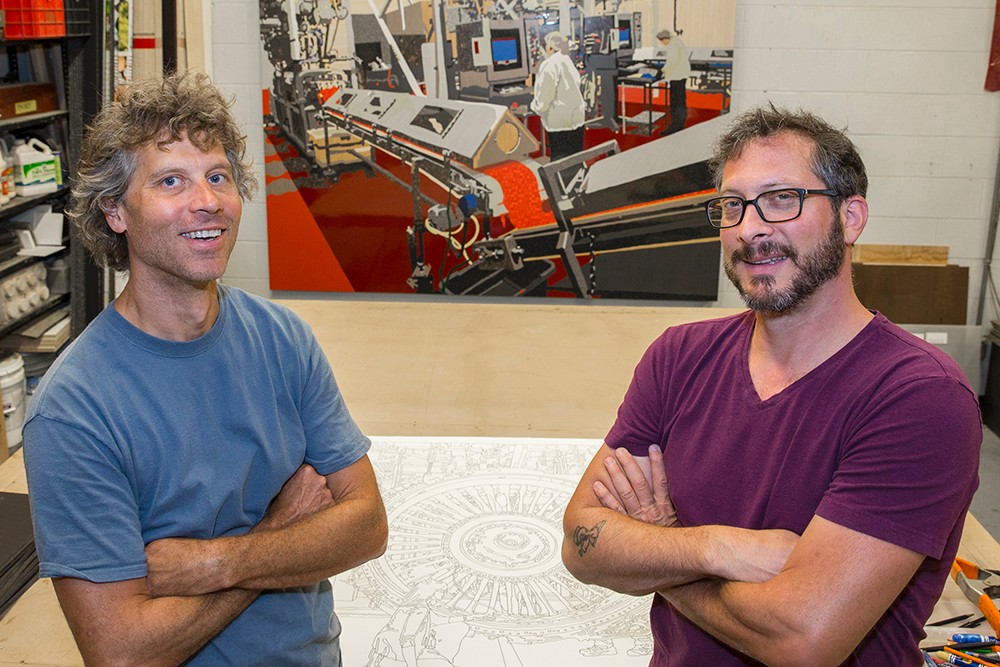
Matt Lynch (left) and Curtis Goldstein pose in front of a line drawing of an engine from G.E. Aviation and a completed mosaic of the Airheads candy factory. Photo/Colleen Kelley/UC Creative Services
“The palette is limited, and that’s part of the fun and part of the skill — to make something out of that pile work,” Lynch says, pointing to Formica tile samples.
Sheet by sheet, the laminate is put through the laser cutter until each piece is cut out. Next, Lynch takes on the daunting task of assembling these pieces, which are taped down and eventually glued in place to create a cohesive image.
The duo’s subjects include the Airheads factory line, Rumpke Recycling, G.E. Aviation and, naturally, Formica. They’re in the process of working with Flavor Producers — a Sharonville company that creates custom flavorings for food, beverage and other applications — and Verdin Bells & Clocks. And while 83 years separate the original worker mural project and the new one, they will share at least one common subject: Rookwood Pottery.
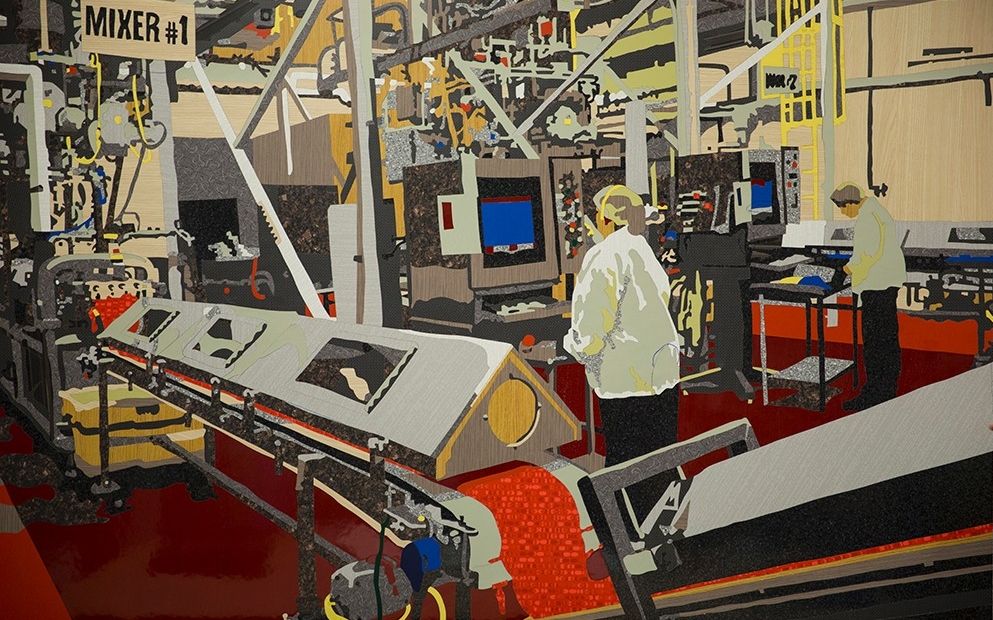
Red Airheads candy makes its ways down the factory line at Perfetti Van Melle in this mosaic. Photo/Colleen Kelley/UC Creative Services
Reiss explored 14 industry subjects for his mosaics, and Lynch and Goldstein hope to eventually complete at least that many. Their works will be on display at Weston Art Gallery in the Aronoff Center during the winter of 2017-18. It’s likely that the project will still be ongoing at that point, and they said they would like to continue as long as possible.
“We’ve limited our subjects to manufacturing,” Lynch says, “but if we look at industries that don’t have a tangible product— whether it’s marketing or Amazon warehousing — there could be a second chapter.”
More recent DAAP stories:
